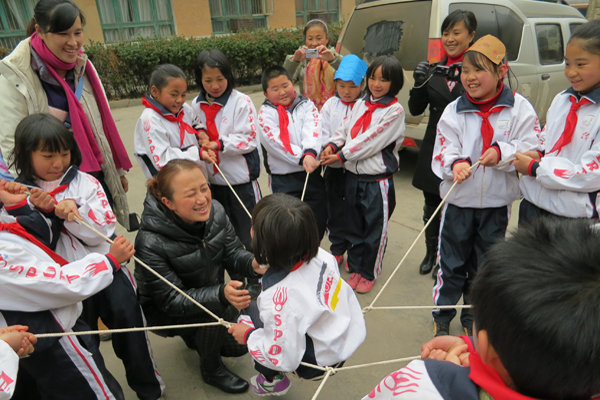 Ms. Huang He (center) from Weining No. 1 Elementary School directs the “Food Web” activity Ms. Huang He (center) from Weining No. 1 Elementary School directs the “Food Web” activityduring the winter environmental camp. | |
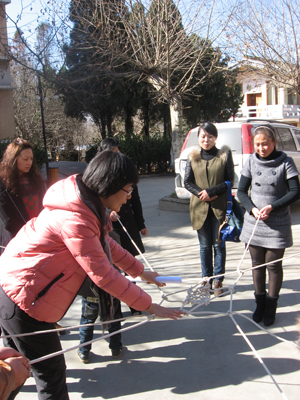 By Dr. Li Fengshan, ICF China Program Coordinator, and Chan Yun-Wen, University of Wisconsin-Madison By Dr. Li Fengshan, ICF China Program Coordinator, and Chan Yun-Wen, University of Wisconsin-MadisonIn late December 2012, Li Fengshan, Ms. Chan Yun-Wen from the University of Wisconsin-Madison, and Ms. Hu Yabin from Beijing No. 39 Secondary School traveled to Caohai Nature Reserve, wintering area for Black-necked and Eurasian Cranes in southwest China. The trip was organized through our project, “Benefiting Caohai Cranes and Communities,” which is supported by the Disney Wildlife Conservation Fund and coordinated among ICF, UW-Madison, Caohai Nature Reserve and local school, Weining No. 4 Elementary School. ICF has been working with the reserve and local villagers for over 20 years to reduce conflict between local residents and wildlife, with a focus on poverty alleviation, wetland research and environmental education.
How do teachers introduce hands-on activities in a classroom with 70-80 students, which is typical in the Caohai area (upper right, a classroom at Weining No. 4 Elementary School)? ICF, UW-Madison and the Caohai Nature Reserve’s approach has been to provide training for local teachers in activities that can be incorporated into modified classroom curricula and special environmental camps. Learn more about this partnership in the first update in this series, Cao Hai Is a Treasure, by CeCe Carter Seiffert. Photos by Hu Yabin, Chan Yun-Wen and Li Fengshan | |
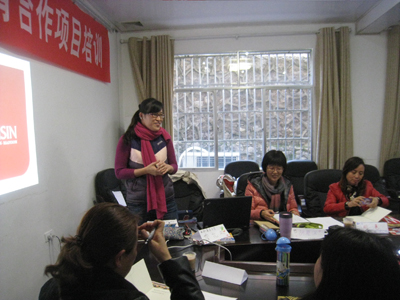 | Chan Yun-Wen from UW-Madison talks about environmental education in Wisconsin schools with local teachers. Yun-Wen is a UW-Madison Ph.D. student in the Department of Curriculum and Instruction, School of Education and a research assistant in the UW’s public service center, the Morgridge Center. |
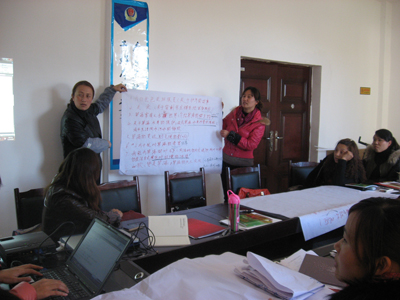 | Ms. Huang He from Weining No. 1 Elementary School and Ms. Xiao Weiqun from Yinlong Elementary School report on the group discussion of the second textbook outline. |
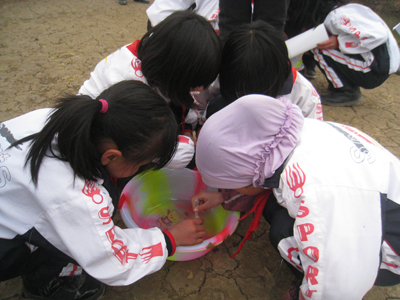 | What lives in the Caohai lake near Weining? Students observe micro-organisms from water samples collected in the lake. |
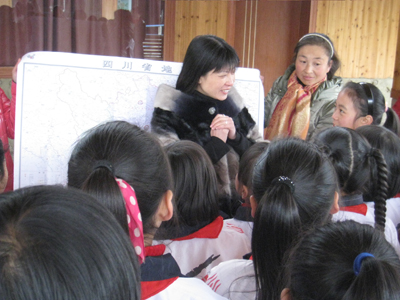 | Ms. Zou Ping from Weining No. 4 Elementary School leads an activity on bird migration during the student camp. |

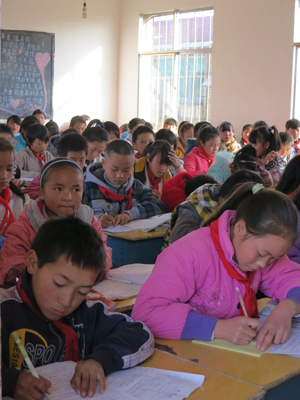 During the trip, a training session was provided for local teachers. Topics presented at the training included environmental education activities from Wisconsin schools, bird resources at Caohai, integrated curriculum teaching from Wisconsin and Taiwan, and curriculum design and development. Demonstrations were made on how to teach the Story of Caohai, a textbook developed by ICF and Beijing-based nonprofit, Beijing Brooks Education Center, and how to design and lead an ecological camp (left, Ms. Hu Yabin demonstrates the “Food Web” activity for local teachers). On the second day of the training, the teachers developed an outline for a second textbook for local schools, and divided responsibilities among the teachers to write lessons for the curriculum. The interdisciplinary approach of the textbook incorporates not only ecological concepts, but also cultural concepts focusing on ancient traditions, religious beliefs, and local knowledge. On the last day, the trained teachers led a winter camp for a group of 20 students from Weining No. 4 Elementary School, in which the students played ecological games/activities and went out for birding and observing aquatic micro-organisms near the lake.
During the trip, a training session was provided for local teachers. Topics presented at the training included environmental education activities from Wisconsin schools, bird resources at Caohai, integrated curriculum teaching from Wisconsin and Taiwan, and curriculum design and development. Demonstrations were made on how to teach the Story of Caohai, a textbook developed by ICF and Beijing-based nonprofit, Beijing Brooks Education Center, and how to design and lead an ecological camp (left, Ms. Hu Yabin demonstrates the “Food Web” activity for local teachers). On the second day of the training, the teachers developed an outline for a second textbook for local schools, and divided responsibilities among the teachers to write lessons for the curriculum. The interdisciplinary approach of the textbook incorporates not only ecological concepts, but also cultural concepts focusing on ancient traditions, religious beliefs, and local knowledge. On the last day, the trained teachers led a winter camp for a group of 20 students from Weining No. 4 Elementary School, in which the students played ecological games/activities and went out for birding and observing aquatic micro-organisms near the lake.